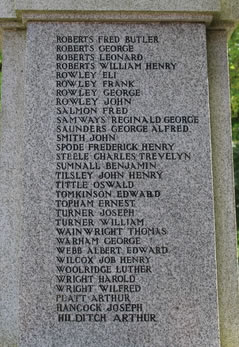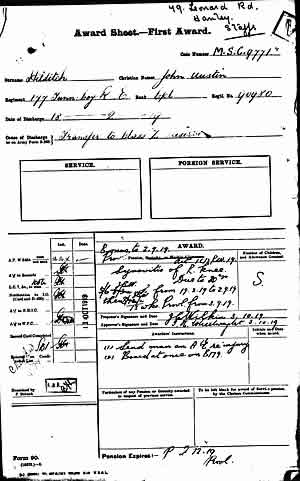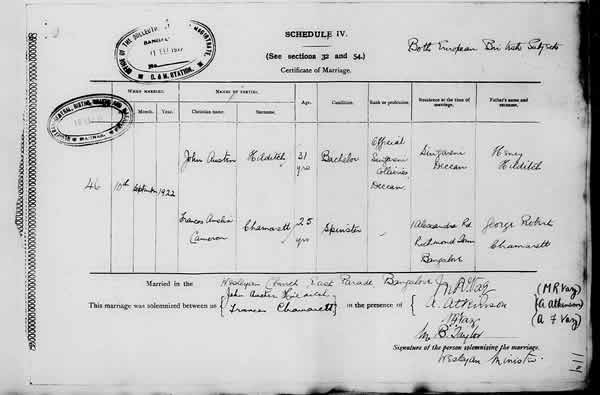| The First World War | |
|
Memorabilia
|
So far I have found four members of the wider Taylor family who served during the First World War. If anyone has photographs of these or any other "veterans" I would be pleased to add their stories to this page. _________________________ Cyril Pentreath Andrew 1892 - 1975
Cyril pictured in 1937 opposite his wife Jessie in their garden at Northwood, with Jim Taylor between them.
Cyril's medical condition when he was examined on enlistment, 18 November 1915. I notice that his vision was perfect - with glasses.
Amongst Cyril's service record documents is an undated medical record headed “Sick List in case of Warrant Officers treated in quarters” which is difficult to read but certainly includes “Bullet entered … back of mid Phalanx of 1st R Finger & came out at back of hand … metatarsal.” Fortunately, Cyril’s Military History Sheet includes the following dates for three occasions when he was injured: "Wounded 19/8/16"; "G.S.Wd. r. arm 16/5/17"; and "G. S. W. R. Hand 2/12/17". He certainly earned the British War Medal and Victory Medal listed on the same sheet. There is one more record in 1916 for treatment Cyril received while on active service. The Admission and Discharge Book for the 39th Casualty Clearing Station states that Pte Andrew, 12295, of the 1st Middlesex Regiment, was treated for suspected dysentery, along with 24 others on the same page, which says a lot about conditions in the trenches. On 9 November Cyril left on the No. 17 Ambulance Train and arrived back in England on 5 December. At this time the 39th Clearing Station was based at Allonville near Amiens.
After Cyril recovered from his final wound in December 1917 the Army seems to have decided he would be best employed in England. Perhaps they noticed he had been an insurance clerk in civilian life and used him in an administrative role from then on. As well as the 1st Battalion, at various times he had been attached to the 5th and 17th Middlesex Battalions where he was described as a Lewis Gunner. Then on 30 September 1918 he was promoted to lance corporal and soon after the Armistice, on 20 November, he was “compulsorily and permanently transferred” to the 1st Battalion Suffolk Regiment as L/Cpl, 67083. He was finally transferred to “Army Reserve on Demobilization” at Warley on 28 March 1819. __________________________
Frederick John Hall 1897 – 1916
Frederick John Hall was the elder son of Frederick Harrington Hall and Alice Hall, née Hilditch, aunt and uncle to Thomas Percy Hilditch; in fact they were the brother and sister of Thomas’s mother and father respectively. Frederick was born in 1897 and joined the 6th Battalion, the “Queen’s” Royal West Surrey Regiment as soon as he was eighteen.
They embarked in June 1915 as reported in the War Diary.
My thanks to J K McKay for permision to the use the photograph of "Jack" Hall.
In July 1916 the battalion was based in trenches opposite Ovillers, near Albert, in the Somme department of the Hauts-de-France. The War Diary picks up the story.
Unfortunately Frederick was the one casualty to be killed on the “quiet” night of 8 July. His mother Alice had buried her husband five months earlier, in February, aged 46, and had now lost her son aged 19. She was left with two daughters aged 6 and 21, and a son aged 8. Pte. Frederick John Hall, G/583 6th Bn. The Queen’s, is remembered on the Thiepval Memorial.
Link to CWGC commemorative certificate for Frederick John Hall __________________________ Arthur Edward Hilditch 1896 - 1918
The name Arthur Hilditch appears on the War Memorial in Audley, Staffordshire but it has been added at the end of the alphabetical list of casualties. This could be because he was living in Hanley when he signed up and perhaps his local origins only came to light later on. Arthur Edward Hilditch was a cousin of Thomas Percy Hilditch, born in Audley on 26 November 1896 to Henry and Eveline Hilditch. In the 1911 census he was recorded as a colliery screen labourer and because he was only 14 years old someone had added “above ground” to his entry. He enlisted on 15 April 1915 and joined the 3rd/5th North Staffordshire Regiment with regimental number 4679. His Medical Inspection Report states his “Apparent age” to be 19 years 5 months whereas he was a year younger than this. He was declared “fit for the Territorial Force” and after transferring to the 2nd/6th Bn. North Staffs Regt. (regimental number 201289) he sailed for France in October 1915, still not quite 19 years old.
His father Henry tried to follow him into the army and attested on the 29 June 1915 with an apparent age of 48 years, 10 months. However, he was discharged on 7 July as “not likely to become an efficient soldier (Med. Grounds)”. Maybe they discovered he was really 54 years old. Was this the reason he joined at Aldershot, a long way from home at 79 Leonard Street, Hanley, Staffordshire? Arthur's brother John also travelled far away from Hanley to enlist and his story follows this one. Arthur’s service record includes treatment “in the field” for an ulcerated stomach in Nov 1915, and a hospital visit and leave in 1917. There is also an entry in April 1916 which may suggest that before the war he had begun to work underground as a miner: “Attd 137th Bdge Mining Coy”. Arthur was recorded as missing on 21 March 1918 and after an inquiry from the British Red Cross and Order of St John he was found to have died as a Prisoner of War in Bavaria on or about 21st/24th March. He was one of 586 “other ranks” listed as missing on that day. The events of the 21st are recorded in the Battalion War Diary. Early in the morning there was a shell gas attack and heavy artillery fire followed by enemy troops attacking over the ground. The account was written by a Major Keating who had assumed command after the senior officer Lieut. Col. Thorne had been shot. Keating was himself taken prisoner and wrote up the entry for the Diary some time later. He described the chaos of their situation: mist and gas, dense white smoke from a direct hit on the Bomb Dump, lost telephone communications, German troops mistaken for British, and the adjacent front had already been overrun. Extract from the War Diary for about mid-day 21 March.
Ecoust is about 10 miles south-east of Arras and Arthur Hilditch is remembered on the Arras Memorial. Link to CWGC commemorative certificate for Arthur Edward Hilditch __________________________ John Austen Hilditch 1891 - 1967 John was born in 1891 to Henry and Eveline Hilditch; his middle name was perhaps chosen in memory of Henry's grandmother Harriet Austin/Austen. He was working as a miner at Deep Pit, Hanley when the war began. He signed up on 29 May 1915 at Great Scotland Yard, some six weeks after his brother Arthur. Why he travelled to London to enlist is a mystery. Did the family want to avoid having two sons in the same regiment? Or did he suspect he might be told to continue working in the mine if he volunteered nearer home? If so he might have been disappointed when he was assigned to the Royal Engineers and told he would be a "tunneller". The first tunnelling companies were formed in early 1915 to combat the highly static trench warfare by digging tunnels to beneath the opposing trenches and then detonating mines. As the war became more mobile in 1917 the tunnellers tended to be employed creating deep dugouts to house troops. Perhaps John enlisted when he did because he had heard that his experience as a miner would be valued by the Army. He must have shown leadership skills as well because, after joining the 177th Company of the Royal Engineers (Regimental Number 96980), he was appointed lance corporal in May 1916.
His condition was assessed and he was awarded a weekly pension until 2 March 1920. See the medical report which also shows his address in Hanley and Regimental Number 90980. After the war John returned to the same family home at 79 Leonard Road, Hanley, Stoke-on-Trent, but to a much changed family: his brother Arthur had died of his wounds in 1918 in a POW camp, his mother Evelyn had died early in 1919 and his two sisters had moved out to work as live-in servants. By the 1921 census, completed on 19 June, his brother Harry and sisters Mary and Florence were all married and John and his father Henry were out of work. More than enough to prompt his next move: sailing from London on the P&O S.N. Company's RMS "Morea" on 24 June and bound for Bombay. John started work with the Singareni Collieries, Deccan, as an official, according to his marriage certificate completed in 1922. His bride was Frances Amelia Cameron Chamarett, daughter of George Robert Chamarett an assistant surgeon with the Indian Army and Ann Louisa Frances Cameron. They were married at the Wesleyan Church, East Parade, Bangalore on 10 September 1922. The record states that they were "Both European British Subjects". Probably a necessary confirmation of nationality since Frances was born in 1896 at Quetta, Bengal, in an area of India which was later to became part of Pakistan.
Marriage record for John Hilditch and Frances Chamarett In 1924 the couple sailed from Bombay to London on the "Caledonia", arriving on 24 June. They were accompanied by two-year-old Dorothy Hilditch, their daughter. By 1939 they were living at 97 Russell Street, Stoke-on-Trent with two more children, May and John, born in 1924 and 1929 respectively. John, senior, was working as an omnibus conductor. _________________________
Return to First World War page
|
| Top of Page |
 Cyril was the husband of Florence Jessie Hilditch, sister of Prof Thomas Percy Hilditch. His Attestation form was dated 18 November 1915, when he was assigned to Army Reserve. He was mobilised in January 1916, but immediately returned to Reserve, and finally mobilised and posted in February of that year. He joined the 1st Battalion, Middlesex Regiment, number 12295 and arrived in France on 1 June, serving there until 22 May 1917 with another period in France from 30 September to 5 December 1917.
Cyril was the husband of Florence Jessie Hilditch, sister of Prof Thomas Percy Hilditch. His Attestation form was dated 18 November 1915, when he was assigned to Army Reserve. He was mobilised in January 1916, but immediately returned to Reserve, and finally mobilised and posted in February of that year. He joined the 1st Battalion, Middlesex Regiment, number 12295 and arrived in France on 1 June, serving there until 22 May 1917 with another period in France from 30 September to 5 December 1917. 





 John's Service Record is missing but his Army Medical Record has useful information about his wartime experiences. He was injured on 3 July 1916 and admitted to hospital on the 4th. By this time he was a corporal and the record shows that he had been injured in the right knee "
John's Service Record is missing but his Army Medical Record has useful information about his wartime experiences. He was injured on 3 July 1916 and admitted to hospital on the 4th. By this time he was a corporal and the record shows that he had been injured in the right knee "